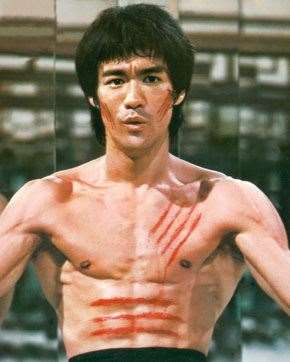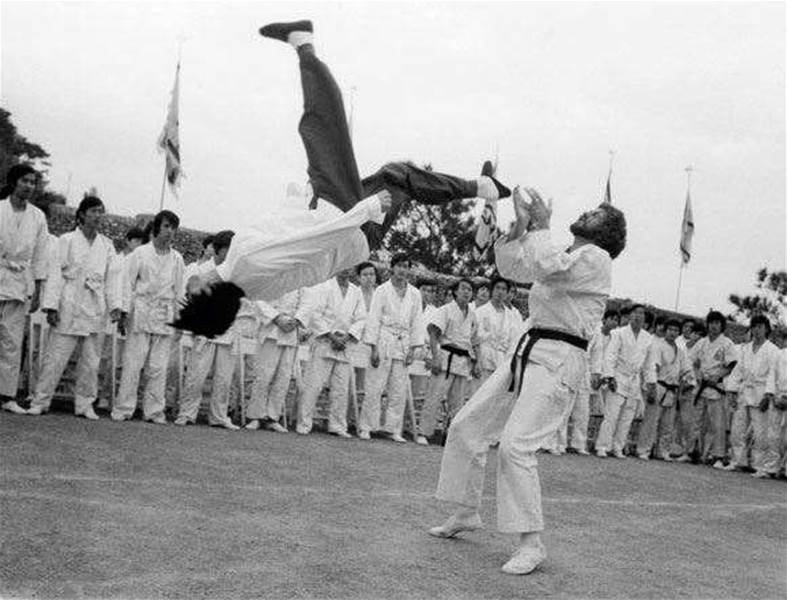It'll be a long time before ar man possessing the mind,body and spirit of Bruce Lee walks the Earth again.
It’ll be a long time before a man possessing the mind, body and spirit of Bruce Lee walks the Earth again.
 Bruce Lee’s acrobatics and strength thrilled everyone. Images: Getty Images
Bruce Lee’s acrobatics and strength thrilled everyone. Images: Getty ImagesWhen Bruce Lee died in mysterious circumstances at the age of 32 in 1973, the world didn’t merely lose a remarkable martial artist who gained worldwide fame in chop-socky movies. It lost a unique philosopher with an unsurpassed ability to harness his mind until it became the complete master of his body, and then mould a body that was able to serve its master’s most outlandish whims. Lee’s physical accomplishments were amazing. A man of relatively small stature, he could perform a range of feats that few, if any, have been able to duplicate. They involved strength, speed, precision, endurance, flexibility and power.With a frame that drew praise from bodybuilders like Lou Ferrigno and Arnold Schwarzenegger for its amazing definition, and with abilities the envy of every athlete in the world, Lee was able to perform stunts many would have considered impossible at the time. Though there are several myths about what he could and couldn’t do, some of the documented achievements are amazing.
Lee was able to lean backward on a bench so that it was just supporting him under his shoulder blades, hands at his sides, then lift his legs straight out so that his entire body was horizontal. He was able to catch grains of rice thrown into the air with chopsticks. His striking speed from a distance of a metre, beginning with his hands down by his side, was 5/100ths of a second. Two-fingered push-ups, one-armed chin-ups. You name it, Lee could do it better than anyone else.There’s a film of him flogging two table tennis champions using nunchaku as his bat. It looks doctored, but not inconceivable. Film of the startling things Lee could do with apparatus like nunchaku and the wooden dummy demonstrate he didn’t need tricks.
The manoeuvres Lee executed in movies like Enter The Dragon and Fists Of Fury were filmed at normal speed, not faster, despite what many think. In fact, some of Lee’s combat movements, according to sources from the day who worked with him on his films, were far too quick to be appreciated, and were shot in 32 frames per second (rather than 24) so viewers could appreciate them.Lee first learned the traditional Chinese Wu style Tai Chi Chuan from his father. His first sifu, or teacher, was the legendary founding father, Yip Man. Yip Man was a master of Wing Chun Gung Fu, an art which emphasises the use of appropriate force, efficiency, balance, relaxation and correct structure. Yip Man’s other illustrious student – a friend of Lee’s – was William Cheung, now the world’s foremost exponent of Kung Fu, and a resident of Melbourne. Because of Lee’s ancestry (his mother was half-German and he was born in California), some students refused to train with him, so Yip Man gave him private lessons.Lee was also trained as a boxer and won several tournaments while still at school. His mentors even then believed he was good enough to be a world-rated professional lightweight or junior welterweight.
 Bruce Lee, Image: Getty Images
Bruce Lee, Image: Getty ImagesAt school, Lee, though very intelligent, was not a remarkable student, and was even accused of plagiarism, an accusation to which his attitude was cavalier. He had read some great philosophers, and, to him, they were there to use. Even many of his adult writings contain unattributed quotes, according to some sources. But in the context of his remarkable body of work, these things are irrelevant.Lee’s genius was his ability to learn, absorb the lessons of his own life and those of other great people, and convert them into physical performance. Once he left university (he completed three years at Washington), his knowledge burgeoned. His library consisted of over 2500 well-thumbed books.
He was able to use the extensive information he gained through experience and book learning to produce an entirely new martial art. At first, the most distinctive feature of Lee’s individual fighting style was his kicking method, which was an improvisation of direct Wing Chun and powerful Northern Shaolin Kung Fu.The art he finally developed was Jeet Kune Do (the Way of the Intercepting Fist). Though he always revered the ancient Chinese martial arts, the style he developed (full name Jun Fan Jeet Kune Do – Jun Fan being his Chinese name) was the “style of no style”. His injunction to his very few students was to “be formless”.Such a development was inevitable, given the way Lee thought. No particular form was ever going to restrict his fighting method, or his thinking. He believed style should change along with one’s physical capabilities, and that those capabilities were developed through weight training (“a big muscle is a strong muscle”), an all-round exercise regime, and diet.
The result was an incredibly explosive, effective and intelligent form of fighting that made Lee simply unbeatable. Though he shunned formal bouts, there’s not a man in the martial arts world who could beat him. Occasionally, on the set or on the street, some poor mug would try, and the result was always the same. The better they were, the more Lee would have to apply “appropriate force”. The very best therefore suffered most.Lee became a one-man revolution. His philosophies, his movies – his very presence – altered many things forever. Martial arts was popularised in the Western world. Lee conceived the show Kung Fu, which ended up starring David Carradine because Hollywood didn’t want a real oriental in it. Lee’s movies set the template for all martial arts films to follow, and no one has found a way to make them better. His beliefs and their practice have application to any sport, and many people in many fields have attained greatness following his principles.Lee became, simply, one of the most influential people of the 20th Century, and continues to be long after his death.
– Robert Drane
Related Articles

Socceroo-in-waiting seals Championship deal

Fringe Socceroo swerves A-League to remain in Europe after Fulham exit












